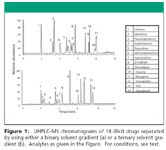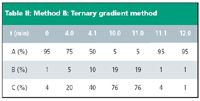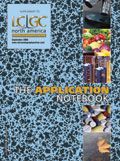Comparison of Binary and Ternary Gradients to Separate Stage 1 Illicit Drugs
The Application Notebook
Improve the separation of 14 drugs of abuse in a complex mixture by employing a ternary solvent gradient.
Guifeng Jiang, Thermo Fisher Scientific
Improve the separation of 14 drugs of abuse in a complex mixture by employing a ternary solvent gradient.
Abinary solvent gradient won't always resolve every analyte in a complex mixture in the short run time of ultra-high performance liquid chromatograph (UHPLC) methods. But the usual solution – manipulating selectivity with a third solvent – is not possible with high pressure binary solvent mixing equipment.

Figure 1
The Accela™ High Speed LC oversteps this limitation by using a quaternary solvent gradient pump. Developing methods is simpler because four solvent channels are available to modify mobile phase solvent strength, pH, and ionic strength. Methods perform better because the Accela pump blends up to four solvents to deliver optimized mobile phase gradients, rather than compromised binary gradients.
We show that a ternary gradient performs better than a binary gradient in the determination of 14 drugs/metabolites by UHPLC/mass spectrometry (UHPLC–MS).

Table I
Experimental Conditions
Instrument: Thermo Scientific Accela UHPLC system
with MSQ Plus™ Detector and
Xcalibur™ 2.05
Column: Hypersil Gold PFP (perfluorinated phenyl),
1.9 μm, 100 × 2.1 mm
Flow Rate: 1 mL/min
Mobile phase: A: Water with 0.06 % (v/v) acetic acid
B: Acetonitrile with 0.06% (v/v) acetic acid
C: Methanol with 0.06% (v/v) acetic acid
Injection: 1 μL partial loop injection, 25 μL loop size
Column Temp: 45°C
Results
We compared two UHPLC–MS methods for the separation and detection of 14 illicit drugs.

Table II
Figure 1(a) shows the separation achieved by using the binary gradient. While some of the analytes separate with adequate resolution, several pairs are not baseline resolved. As shown in Figure 1 (b), the ternary gradient provides a better separation and all 14 drugs are baseline resolved.
Conclusion
UHPLC–MS employing a ternary gradient delivered by a quaternary mixing pump provides baseline resolution of 14 illicit drugs in 10 min.
Reference
(1) Application Note 423, Document 62751, 2008, Thermo Fisher Scientific.

Thermo Fisher Scientific Inc.
355 River Oaks Parkway, San Jose, CA 95134-1991
tel. +1 800-532-4752; fax +1 561-688-8731

Free Poster: NDSRI Risk Assessment and Trace-Level Analysis of N-Nitrosamines
April 25th 2025With increasing concern over genotoxic nitrosamine contaminants, regulatory bodies like the FDA and EMA have introduced strict guidelines following several high-profile drug recalls. This poster showcases a case study where LGC and Waters developed a UPLC/MS/MS method for quantifying trace levels of N-nitroso-sertraline in sertraline using Waters mass spectrometry and LGC reference standards.
New TRC Facility Accelerates Innovation and Delivery
April 25th 2025We’ve expanded our capabilities with a state-of-the-art, 200,000 sq ft TRC facility in Toronto, completed in 2024 and staffed by over 100 PhD- and MSc-level scientists. This investment enables the development of more innovative compounds, a broader catalogue and custom offering, and streamlined operations for faster delivery. • Our extensive range of over 100,000 high-quality research chemicals—including APIs, metabolites, and impurities in both native and stable isotope-labelled forms—provides essential tools for uncovering molecular disease mechanisms and exploring new opportunities for therapeutic intervention.
New Guide: Characterising Impurity Standards – What Defines “Good Enough?”
April 25th 2025Impurity reference standards (IRSs) are essential for accurately identifying and quantifying impurities in pharmaceutical development and manufacturing. Yet, with limited regulatory guidance on how much characterisation is truly required for different applications, selecting the right standard can be challenging. To help, LGC has developed a new interactive multimedia guide, packed with expert insights to support your decision-making and give you greater confidence when choosing the right IRS for your specific needs.
Using the Carcinogenic Potency Categorisation Approach (CPCA) to Classify N-nitrosamine Impurities
April 25th 2025Learn how to manage nitrosamine impurities in pharmaceuticals with our free infographic. Discover how the CPCA approach establishes acceptable intake limits and guides the selection of NDSRI reference samples. Stay compliant and ensure safety with our ISO-accredited standards.

.png&w=3840&q=75)

.png&w=3840&q=75)



.png&w=3840&q=75)



.png&w=3840&q=75)














